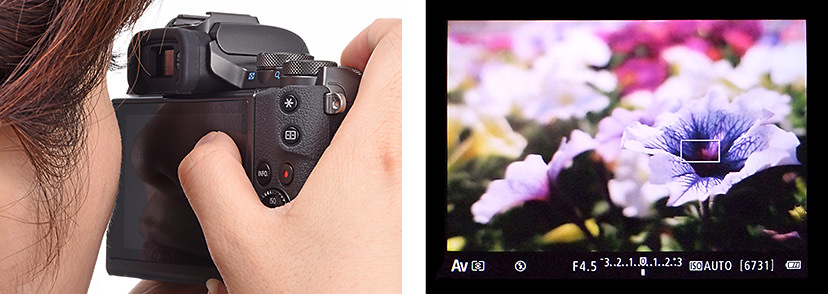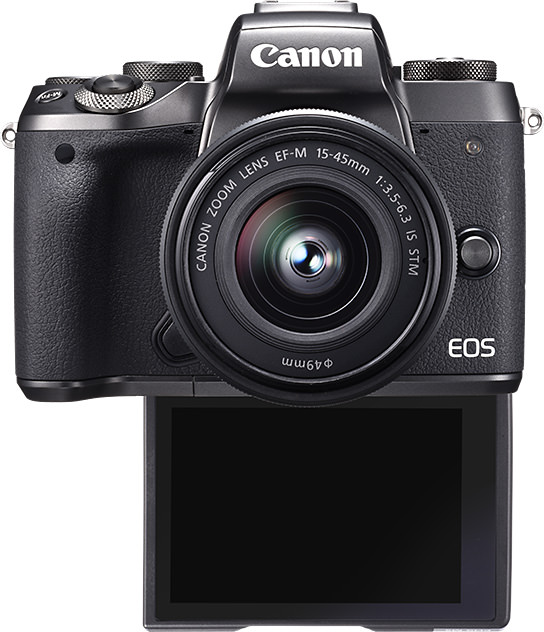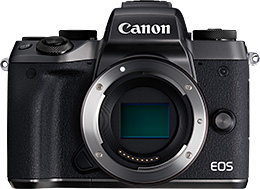EOS M5 Review Part 1: Built-in EVF Will Delight Aspiring Professional Photographers
Canon’s EOS M line of mirrorless cameras has gained a reputation for shooting prowess and high image quality, and it is amid such expectations that the series flagship EOS M5 was announced in September 2016. Serious users with professional photography aspirations will take well to its body design, which incorporates a built-in electronic viewfinder (EVF). In this review, we take a closer look at this camera and what it is capable of. (Reported by: Kazuo Nakahara)

*This review was done with a prototype, and may differ in external appearance from the actual product.
Features Dual Pixel CMOS AF for speedy autofocus
The biggest advancement on the EOS M5 is that it is the first EOS M-series camera to feature an approximately 24.2-megapixel sensor, which in turn supports the use of the Dual Pixel CMOS AF system, capable of carrying out speedy autofocus via image plane phase difference detection AF.
Dual Pixel CMOS AF speeds up AF during Live View shooting, to a point where it is on par with the phase difference detection AF system active during viewfinder shooting. This overcomes a common vulnerability found on mirrorless cameras, wherein AF speed may be slower for some scenes. I tested the EOS M5 on a variety of subjects moving and still, and experienced firsthand the AF that was so speedy and effortless, it felt as though I was shooting on a DSLR camera.
The DIGIC 7 imaging processor enables diffractive blur compensation, which aids when shooting with small apertures (large f-numbers), such as during pan focus. Noise reduction capabilities have also been improved, with the normal ISO speed upped to ISO 25600. On mirrorless cameras, information from the imaging sensor needs to be analysed and processed in real time, which means that the speed and ease of shooting are quite dependent on the capabilities of the imaging processor. The improvement in AF tracking thanks to DIGIC 7 and the achievement of seamless EVF display all work in combination with Dual Pixel CMOS AF to realize an advanced camera with powerful high speed shooting capabilities, great for capturing moving subjects.
![]()
A: Photodiode A
B: Photodiode B
C: Pixels able to perform phase difference detection AF
Dual Pixel CMOS AF makes use of phase difference detection sensors positioned on all image pixels to carry out image plane phase difference detection AF.
Built-in EVF with approximately 2.36 million dots
As the first camera in the EOS M-series to feature a 2.36 million-dot high-definition built-in EVF, the EOS M5 boasts of a body design that is very similar to that of DSLR cameras. Slightly bigger than the EOS M3, its rear LCD monitor, tiltable upwards and downwards, is larger than before, at 3.2-inches with approximately 1.62 million-dots of effective pixels. Its structure is just right even for self-portraits, and from the easy-to-hold grip and increase in buttons and controls, it is apparent that the camera has been designed with a seamless shooting experience in mind.

The eyepoint is 22mm, which allows even users who wear glasses to enjoy an unobstructed view through all 4 corners of the viewfinder.

The EOS M5 incorporates a new Touch & Drag AF feature, which allows the instant, intuitive touchscreen selection and repositioning of AF frames while looking through the EVF. It is a convenient feature to have for keeping up with subject movements, as well as for establishing pinpoint focus on fine areas.
Exterior design also ups the amp in user-friendliness
A new dial function ([DIAL FUNC.]) button and Quick Control dial have been added to the top portion of the camera body. The [DIAL FUNC.] button enables the quick switching through various adjustable functions such as white balance, ISO speed and AF mode, in order to adjust their settings. As these button are positioned a bit further away from the grip, it may take some getting used to them, but this grouping together of most-often-used functions makes it easier to operate the camera without having to look away from the viewfinder.
The front cover, rear cover and grip are made of a polycarbonate and synthetic rubber, with a high-quality, textured surface finish. The dials and controls too, feel luxurious to the touch. As the camera supports not only Wi-Fi but also Bluetooth low energy technology, many features allow Bluetooth pairing with smartphones. Canon has spared no effort with this mirrorless camera, which is cause for delight.

Pressing the [DIAL FUNC.] button displays the settings for functions such as WB and ISO speed, and turning the Quick Control dial allows you to set the values for these functions.

The built-in pop-up flash. On the EOS M3, this was located to the side of the camera, but on the EOS M5, it is to the centre of the body.

The rear LCD tilt-type monitor, which is tiltable to approximately 85° upwards and 180° downward.

The grip is deeper than on previous models, allowing a firmer hold. The left panel features a remote control terminal. The right panel features a mini HDMI output terminal and the Wi-Fi button.
SPECIFICATION
Image sensor: Approx. 24.2MP CMOS sensor
Autofocus type: Dual Pixel CMOS AF
AF points: 49 points
Imaging processor: DIGIC 7
ISO speed: 100 - 25600
Continuous shooting speed: 9 fps (with AF lock), 7 fps (with AF tracking)
Shutter speed: 1/4000- 30 sec.
LCD monitor: Wide, 3.2 inches (3:2), approx. 1.62 million dots, tiltable approx. 85° upwards , approx. 180° downwards
Built-in EVF: Included
Built-in flash: Included
Networks: Wi-Fi, NFC, Bluetooth low energy technology
Dimensions(W × H × D): Approx. 115.6 ×89.2 × 60.6mm
Weight: Approx. 427g (including batteries, memory card)
*Text in red indicates features that are new/improved.
Receive the latest updates on photography news, tips and tricks by signing up with us!

EOS M5 (Body)

Born in Hokkaido in 1982, Nakahara turned to photography after working at a chemical manufacturing company. He majored in photography at the Vantan Design Institute and is a lecturer for photography workshops and seminars, in addition to working in commercial photography. He is also a representative of the photography information website studio9.

A monthly magazine that believes that enjoyment of photography will increase the more one learns about camera functions. It delivers news on the latest cameras and features and regularly introduces various photography techniques.
Published by Impress Corporation

































